MONTHLY HMAR UPDATE: SEPTEMBER 2022
Check out what HMAR has been up to in September and a sneak peek of what’s to come over the next month! We feel like every month rushes by, but it’s seriously true, and September was no exception! Happy Fall, all, here’s our September update!
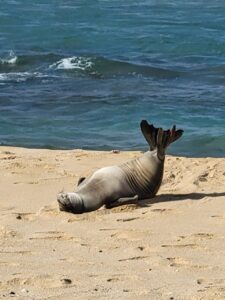 Number of Calls to HMAR – 394 (about 13 per day)
Number of Calls to HMAR – 394 (about 13 per day)
Our hotline operators were busy this month, taking 394 calls! Of these, 292 were related to Hawaiian monk seals, 76 calls were for sea turtles, and there were 26 calls related to seabirds.
Number of Field Support Actions – 204 Total (about 7 times each day)
Our activity in the field in September was divided by areas of the island: North – 2, East – 100, Southeast – 13, West – 89).
First things first, PO9 “Lehiwa” (see picture left) now has an official permanent ID of RQ72! On September 12th, our responder arrived to monitor Lehiwa and her mom R016 “Right Spot” to find no mom in sight! A few days later, NOAA gave Lehiwa her permanent ID and tags! Since weaning, Lehiwa has been hanging out in her little tide pool where she was born and learning how to forage. As we have seen with other monk seal “weaners” (weaned pups), Lehiwa has been observed playing with and biting sea cucumbers. This can result in the sticky guts of the sea cucumber getting stuck to the animals’ pelage (fur) and vibrissae (whiskers). Sometimes, without examining photographs closely, this organic material can look like monofilament fishing line or even a hook. There has also been some concern for Right Spot. To get more information on her, see our previous post on our Facebook and Instagram. At this point, HMAR and NOAA are actively monitoring her body condition and behaviors as frequently as possible.
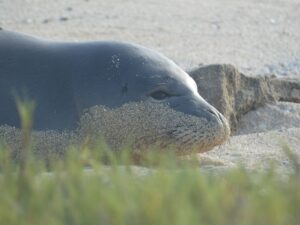
We’re also continuing to monitor RQ58 “Koalani” since he was relocated from Waikiki to his new home (see picture right). He is still doing well and we are observing him frequently in his new area. We are so glad that he seems to be adjusting well to his new home!
Since April, our Marine Operations team has been working to survey many of the offshore islets for sea turtle nests in a project with the U.S. Fish & Wildlife Service. We’ve completed surveys using our HMAR kayaks or on our Rescue 1 vessel each week. At the end of September, we officially finished our surveys for the year to learn how the offshore islets are being used by sea turtles for nesting. Unfortunately, we didn’t find any confirmed nests this year but did see some possible activity. We also got to see numerous Hawaiian monk seals, sea turtles, and spinner dolphins. Science takes effort and we’re hopeful for next year!
Number of Rescues, Interventions, Stranding Responses and Escalated Field Actions – 31 Total (about 1 each day)
In September, this was broken out as Hawaiian monk seals – 0, sea turtles – 18, seabirds – 13, and cetaceans – 0. These activities were divided by areas of the island: North – 7, East – 18, Southeast – 6, West – 0).
September was the month of happy sea turtle rescues! We don’t always have happy endings. Sadly, often our turtle rescues result in finding a deceased sea turtle, or a sea turtle that is later euthanized because it is the most humane thing to do. But, this month, we had some happy endings we wanted to share!
On a very busy Friday with four turtle calls, our responder Evelyn (see picture right) headed to the North Shore to respond to a report of a sea turtle stuck in between two rocks (see picture left). This sometimes happens when turtles are in the
in between two rocks (see picture left). This sometimes happens when turtles are in the 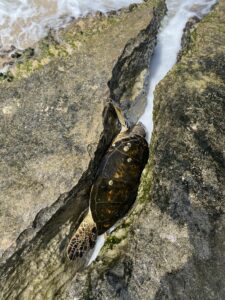 wrong place at the wrong time. Due to wave action and difficult conditions, this was a challenging rescue for us as we had to be incredibly careful of how we were going to un-wedge the sea turtle without causing injury to the sea turtle or our responders. This rescue required 3 HMAR responders as well as several members of the public. It required Evelyn to get underneath the sea turtle with a towel in very tight quarters while other HMAR responders and the public helped from above. Using the waves’ power, the team successfully removed the sea turtle from the rocks after a bit of adjustment. Then, after our health assessment of the animal, the sea turtle was deemed ready for release right there! It quickly swam away just as we had hoped (see video below)!
wrong place at the wrong time. Due to wave action and difficult conditions, this was a challenging rescue for us as we had to be incredibly careful of how we were going to un-wedge the sea turtle without causing injury to the sea turtle or our responders. This rescue required 3 HMAR responders as well as several members of the public. It required Evelyn to get underneath the sea turtle with a towel in very tight quarters while other HMAR responders and the public helped from above. Using the waves’ power, the team successfully removed the sea turtle from the rocks after a bit of adjustment. Then, after our health assessment of the animal, the sea turtle was deemed ready for release right there! It quickly swam away just as we had hoped (see video below)!
A few weeks later, McKinley and Emily responded to a sea turtle hauled out at Laniakea Beach with a hook and line in her neck. After an exam and check on the hook, our responders, along with our partners at NOAA, decided that removing the hook was too risky on the beach. Instead, we cut the line and released the sea turtle. Now, this might sound surprising, that the sea turtle was re-released with the hook still in its neck. Thankfully, sea turtles have thick skin and although the hook was embedded, this sea turtle is in good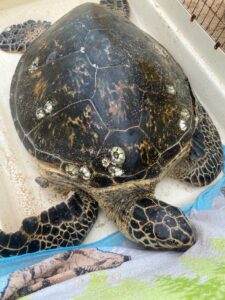 body condition (see picture right) and in a location where we can continue to monitor her with help from our friends at Malama i na Honu. For now, we want to give her the chance to live a healthy life at sea; the hook will likely rust out and not cause any further harm.
body condition (see picture right) and in a location where we can continue to monitor her with help from our friends at Malama i na Honu. For now, we want to give her the chance to live a healthy life at sea; the hook will likely rust out and not cause any further harm.
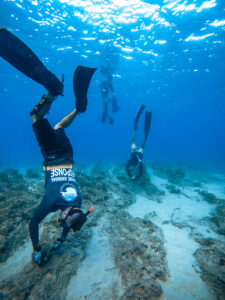
Marine Debris – More Great Results in September!
In September, our Marine Debris Program (MDP) conducted four dives (see picture left)! We collected 1,819 feet of monofilament lines and 81 animal hazards. And we cleaned a total of 7.3 acres! During September, many marine animals visited us while conducting our marine debris dives. From honu, squids, and eels to an inquisitive monk seal! The seal stopped by to observe our operations. Though he was quite curious, our group maintained a proper distance. Once satisfied with our work, he swam over to our dive float and inspected it for quite a while before departing! Visits from these animals like these remind us why it’s so important to remove derelict fishing gear and other hazards from the ocean. It gives these amazing creatures the space to roam about freely and safely.
 Number of People Reached Through Face to Face Outreach – 2,337
Number of People Reached Through Face to Face Outreach – 2,337
With the school year in full swing, HMAR’s Education team headed up by Emily (see picture right) has started a new school program, a recurring educational series! We had our first session with Hau’ula Elementary, and we will continue to meet with their fourth graders each month for the rest of the school year, discussing a different topic each time. We will also complete this series with Waianae Intermediate, Kahuku Elementary, and other schools this year!
October will be full of Halloween events! We are partnering again with Aaron’s Dive Shop and KidZArt Kailua to host a community beach cleanup! The event will be on October 22nd from 8 am-11 am at Kailua Beach Park. Since it’s so close to Halloween, we’ll also be dressing up in costumes, and there will be games!
Additional News & Updates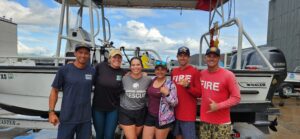
Two of our employees, Anabel and Emily (center in picture left), attended NOAA’s Motorboat Operator Certification Course (MOCC) this month. This means 5 of our 6 Oahu employees have now been certified! MOCC includes classroom and practical exercises such as docking, confined space maneuvering and obstacle avoidance. Anabel manages our Marine Operations Program and our Marine Debris Program while Emily is our Education & Engagement Program Manager. This course is a great experience for our staff; they have lots of fun, and it provides great training we can use on HMAR vessels as we support marine debris removal, surveys for animals of concern, rescues, and stranding responses!
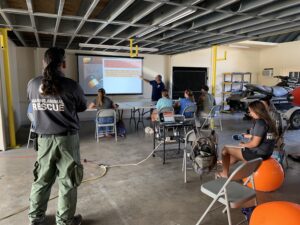 HMAR has an upcoming volunteer orientation! October 15th is the next orientation and training date for new volunteers (see picture left)! If you have ever been interested in volunteering with us before, this is the best time to apply HERE! We will get back to you ASAP and get you into the October training date!
HMAR has an upcoming volunteer orientation! October 15th is the next orientation and training date for new volunteers (see picture left)! If you have ever been interested in volunteering with us before, this is the best time to apply HERE! We will get back to you ASAP and get you into the October training date!
We have had several new and returning sponsors this month as well! Among them are Aaron’s Dive Shop, Nudi Wear, and Cora Ball! Keep an eye on our social media in the next few days to learn more about these amazing organizations and support their work!
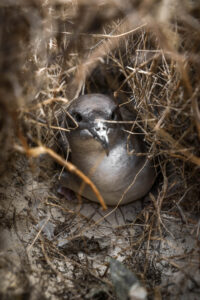 Now that September is over, “fallout season” is coming up quickly! Some seabird chicks, like wedge-tailed shearwaters, will soon be leaving their burrows (see picture right) for the first time to head out to sea. Artificial lighting from buildings, houses and street lights can confuse the birds, who end up so disoriented and exhausted that they “fall out” of the sky leaving them vulnerable to predation, getting hit by vehicles, and other risks. Thankfully most of these birds are typically just fine after a bit of rest but our team is ready for a busy season of seabird rescues. So, how can you help? For the last three months of the year, turn off all outside lights and close your curtains at night. And if you see a downed bird at any time of the year, please give these birds a good shot at recovery by calling the NOAA Marine Wildlife Hotline at 888-256-9840.
Now that September is over, “fallout season” is coming up quickly! Some seabird chicks, like wedge-tailed shearwaters, will soon be leaving their burrows (see picture right) for the first time to head out to sea. Artificial lighting from buildings, houses and street lights can confuse the birds, who end up so disoriented and exhausted that they “fall out” of the sky leaving them vulnerable to predation, getting hit by vehicles, and other risks. Thankfully most of these birds are typically just fine after a bit of rest but our team is ready for a busy season of seabird rescues. So, how can you help? For the last three months of the year, turn off all outside lights and close your curtains at night. And if you see a downed bird at any time of the year, please give these birds a good shot at recovery by calling the NOAA Marine Wildlife Hotline at 888-256-9840.
On September 30th, our Quarter 3 internship ended, and we said goodbye to three awesome interns! Josh, Haylie, and Jace have been an integral part of HMAR for the past four months, spending dozens of hours at Kaimana Beach with Koalani or on the west side with seals. Our interns are an important part of our organization, and we couldn’t operate without them! Interested in interning with us? Go HERE to apply! We’re currently signing up interns for the Spring 2023 semester!
Thank You!
As always, we can’t do the work we do without all of you! We rely heavily on public donations to pay for gas, supplies, staff, and all the other things we need to do our work. Marine animal response, rescue, and education is rewarding, but not inexpensive. If you want to support us, you can donate HERE and every dollar helps. Mahalo for your support!
______________________________________________________________________________
WHAT DO THESE NUMBERS MEAN?
Number of Calls – What does this mean? These are calls our hotline operators answer about any species in any situation. Whether it is a monk seal on the beach, a sea turtle of concern in the water, or a seabird that needs help. HMAR answers the calls that are made to the NOAA’s marine wildlife number for Oahu and Molokai and we take calls from the public, from the police, fire department, Ocean Safety as well as State of Hawaii agencies. Any call that comes into our hotline is reported here. Some calls result in a field response but many are valuable for animal sightings information or other data that can assist in research. Since our start in 2016, we’ve taken nearly 50,000 calls.
Number of Field Support Actions – What does this mean? This is when HMAR sends volunteer or staff resources into the field to perform a variety of actions in support of marine protected animals including Hawaiian monk seals, sea turtles, sea birds, dolphins, and whales. Since our start in 2016, we have had volunteers or staff in the field over 22,500 times.
Number of Rescues, Interventions, Stranding Responses and Escalated Field Actions – What does this mean? This number includes any field response that goes above and beyond a typical resting monk seal response. This includes responding to a seal of concern, an entangled, hooked, or injured sea turtle, a seabird in need of medical support, and other situations. Since 2016, we have performed over 1,850 of these actions.
Marine Debris Work – Each week our marine debris team removes underwater entanglement hazards (net, line, hooks) from high fishing pressure areas to reduce animal entanglements, hookings, injuries and death of protected marine animals. Since we started our underwater removal activities, our Marine Debris Program (MDP) has removed more than 3,600 animal hazards, cleaned over 220 acres of underwater habitat, and we have collected many miles of monofilament fishing line. Taking all of this debris out of underwater habitat helps save Hawaiian monk seals, sea turtles, and seabirds.
Number of People Reached through Face to Face Outreach – What does this mean? HMAR’s different program activities put our volunteers and staff in direct contact with Hawaii’s residents and visitors. Educating people about Hawaii’s marine protected species and our ocean ecosystem is one of our highest priorities and has an important impact on reducing threats. This number includes outreach done on the beaches as well as the work our Education and Engagement team does going to classes and community outreach events. Since our start we’ve reached nearly 280,000 people.
